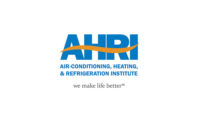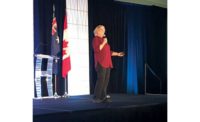
After a luncheon keynote address at the Gas Appliance Manufacturers Association (GAMA) meeting in St. Petersburg, Fla., Thomas Donohue, U.S. Chamber president/CEO gathered with industry leaders. Pictured left to right: Jack Klimp, GAMA president; Bill Rafferty, outgoing GAMA chairman and executive vice president of Mestek Inc.; Donohue; and Patrick Quilty, incoming chairman of GAMA and vice president and general manager of Combustion Controls, Honeywell International.
Coming off a record enrollment year with 18 new companies bringing GAMA’s total membership to 205 companies, the association also boasted its largest attendance ever for the 72nd Annual Meeting, held May 5-8, at the Renaissance Vinoy Resort & Golf Club, St. Petersburg, Fla. Ninety first-time attendees contributed to the record attendance of 375 registered members.
In addition to a strong lineup of seminars and keynote speakers, attendees were often found discussing a possible merger between GAMA and the Air-Conditioning and Refrigeration Institute (ARI). GAMA Chairman of the board, Bill Rafferty, executive vice president of Mestek Inc., devoted a portion of his general session opening speech to the topic. Also, Rafferty and GAMA President Jack Klimp made the rounds at all the committee meetings to provide an overview of the suggested merger. (See related article “GAMA, ARI Continue to Explore Merger” in this issue.)
Rafferty opened the session with less of a recap of past accomplishments and more of a focus on longer-term strategic issues confronting the industry.
“In the past, it has been standard practice for industry groups to resist any and all regulated changes on issues pertinent to their industry. In our case, this would include new efficiency standards and the like. With this approach industries would often be viewed as obstructionist and looking at all issues through a prism of self-interest.
“By taking these types of positions, we often find ourselves on the wrong side of the issues. As an example, I believe there are few in this room who wouldn’t agree that energy costs, its availability and environmental concerns, will continue to be crucial issues for the foreseeable future, yet our collective instinct is to resist any and all regulated improvements in these areas.”
Rafferty continued to say that the industry should accept change for the better if done in an orderly and responsible way. “It’s particularly important now that we proactively and constructively deal with the issues as I haven’t seen this pace of changes in our industry since the energy crisis of the 1970s. Our positions and concerns will likely be heeded only to the extent that they appear reasonable and not solely self-serving,” he said.
Rafferty related how a cooperative effort between the hydronics institute division of GAMA and the energy and environmental advocates produced a model for future cooperations.
The two groups met to discuss issues and concerns with certain facets of the new energy bill that is quickly making its way through Congress. The proposed 84 percent minimum efficiency standard would have had the effect of lessening the margin of safety for the adequate venting of gas boilers.
Rafferty said, “During a meeting, GAMA representatives proposed a technical solution that would save more energy than the proposed efficiency standard and offered to accelerate its implementation. A consensus was reached on an 82 percent efficiency requirement. The two sides entered into a gentleman’s agreement to support the new proposal regardless of the decision that the Department of Energy (DOE) might make regarding the consensus agreement.
“DOE did reject the agreement on purely technical grounds. When this new energy bill was introduced, however, the energy and environmental advocates remained true to their word and fully supported the consensus agreement.”
The end result was that the new energy bill eventually included the consensus agreement, largely due to the support from those advocates. Rafferty’s comments were directed to the audience as his own personal views though he suspected that many may share his thoughts. “As an industry, we need to be out in front and on the right side of the issues. If we can develop consensus positions within the association that recognize the current realities and trends, we can be more effective in accomplishing our collective goals and protecting our mutual interests,” said Rafferty.
MEETING HIGHLIGHTS
Economic expert James Glassman and U.S. Chamber President/CEO Thomas Donohue offered their forward thinking and sometimes humorous insights during the opening session and luncheon.In addition to his views on politics and the U.S. and global economy, Glassman shared his interesting take on the shifting work force. “In 1969, the work to retirement ratio (W/R) was 45 workers for every one retiree. In 2006, the W/R ratio had changed to 42/20. That means that not only are there fewer people supporting our retirement systems, but that many more retirees are on the rolls.” Glassman noted that not only is the social security and Medicare system stretched thin, but the changing demographic of the workplace is causing people to rethink hiring practices.
Donohue received the GAMA Public Service Award during the convention, and then entertained the meeting attendees for nearly an hour after lunch on May 7.
“We come from a vast gene pool. We are a tough people who have told everybody else in other countries how to work and how to live. They got fed up with hearing us so they did it. And, now we’re complaining because they are competing with us?” he said.
Donohue spent part of his time speaking about the changes that would be needed in the country’s infrastructure in order to support continued economic growth. He referred to the infrastructure as the “monkey wrench in our economy’s future.”
The Major Issues Briefing was also a well-attended function. Top on the list of discussion points was national and state energy legislation. Currently, a Senate bill (S. 1115) authorizes the DOE to determine that regional energy-efficiency standards are justified for up to three regions for space heating and air conditioning equipment. Today, the DOE has no regional authority. S. 1115, as introduced, would also allow federal preemption to lapse where DOE has concluded in rulemaking that a national standard for a subclass of federally-covered product is not justified or cannot be rationally determined.
The end result of the legislation is that regions or states could supersede federal standards and create a very complicated manufacturing environment.
During the annual passing of responsibility, Rafferty handed the gavel to incoming chair, Patrick J. Quilty, vice president and general manager of Combustion Controls, Honeywell International. As GAMA’s top elected leader, Quilty will serve a one-year term as chairman of the GAMA executive committee and the board of directors. He and the 43-member board develop overall policy for the organization.
Publication date:06/11/2007







